Yunnan is a province located in the southwestern part of China and is known for its diverse culture, stunning landscapes, and mild climate. It is known for its stunning natural beauty, Yunnan offers everything from the dramatic peaks of the Jade Dragon Snow Mountain to the serene waters of Lugu Lake. The province is also rich in cultural heritage, with ancient towns like Lijiang and Dali offering glimpses into the region’s history and traditions.
It borders Myanmar, Laos, and Vietnam, making it a significant cultural and trade crossroads.
Yunnan is home to a large number of ethnic minorities, each with unique traditions and customs, contributing to the province’s rich cultural tapestry.
Let’s see what to visit in Yunnan on your China trip.
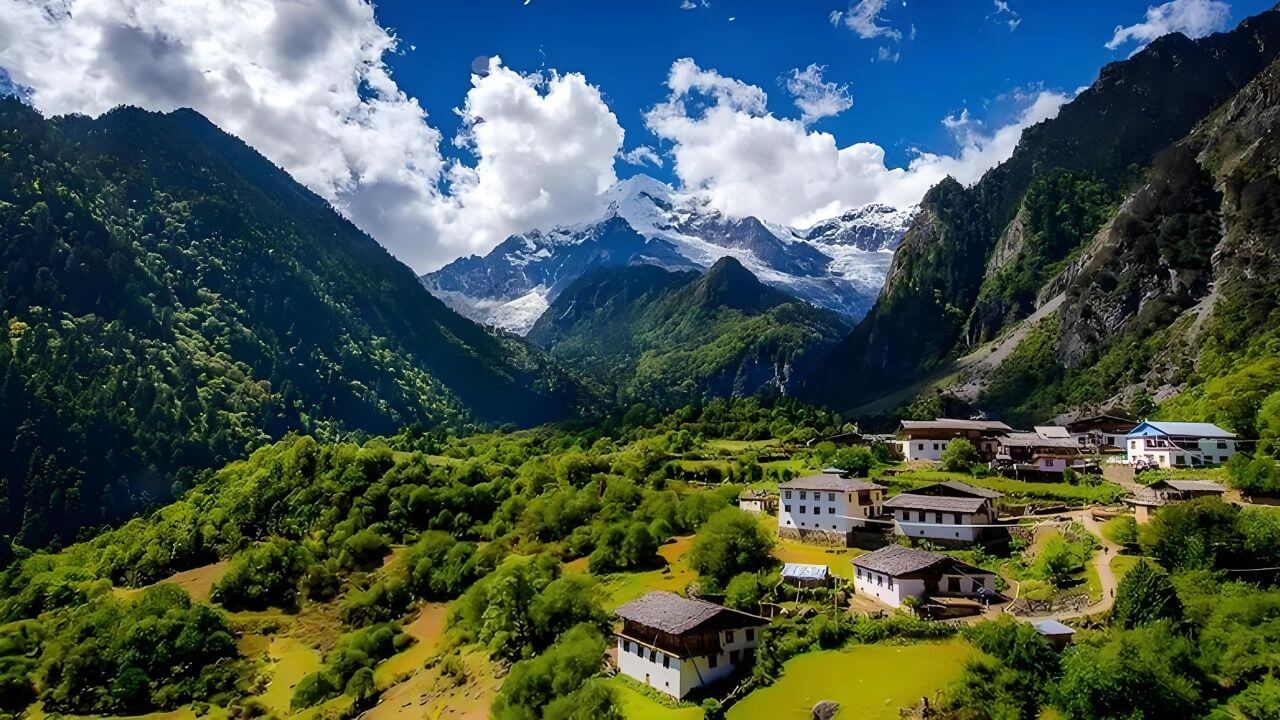
Lijiang Ancient Town
Lijiang Ancient Town is also known as Dayan Old Town. It is a UNESCO World Heritage Site located in Lijiang in Yunnan Province. Known for its well-preserved architecture and rich cultural heritage, it serves as a vibrant living museum showcasing the history and traditions of the Naxi ethnic minority. The town’s history dates back over 800 years and is renowned for its unique blend of Han, Bai, and Naxi cultures.
What to see in Lijiang Ancient Town
- Mu’s Residence: Once the home of the Mu family, rulers of Lijiang for over 500 years, this large complex resembles a miniature Forbidden City with beautiful architecture and serene gardens.
- Square Street (Sifang Jie): The bustling heart of Lijiang Ancient Town, filled with shops, cafes, and restaurants. It’s the perfect place to experience the local culture and buy traditional crafts.
- Waterways and Bridges: The town’s intricate system of canals and stone bridges gives it a charming, picturesque quality, often earning comparisons to Venice.
- Wangu Pavilion: Located on Lion Hill, this pavilion offers panoramic views of the entire town and the surrounding mountains, providing a great spot for photography.
- Black Dragon Pool (Heilongtan Park): A short walk from the town, this park is famous for its clear waters reflecting the stunning Jade Dragon Snow Mountain.
- Dongba Culture Museum: This museum provides insights into the Naxi people’s Dongba culture, including their unique pictographic script and religious traditions.
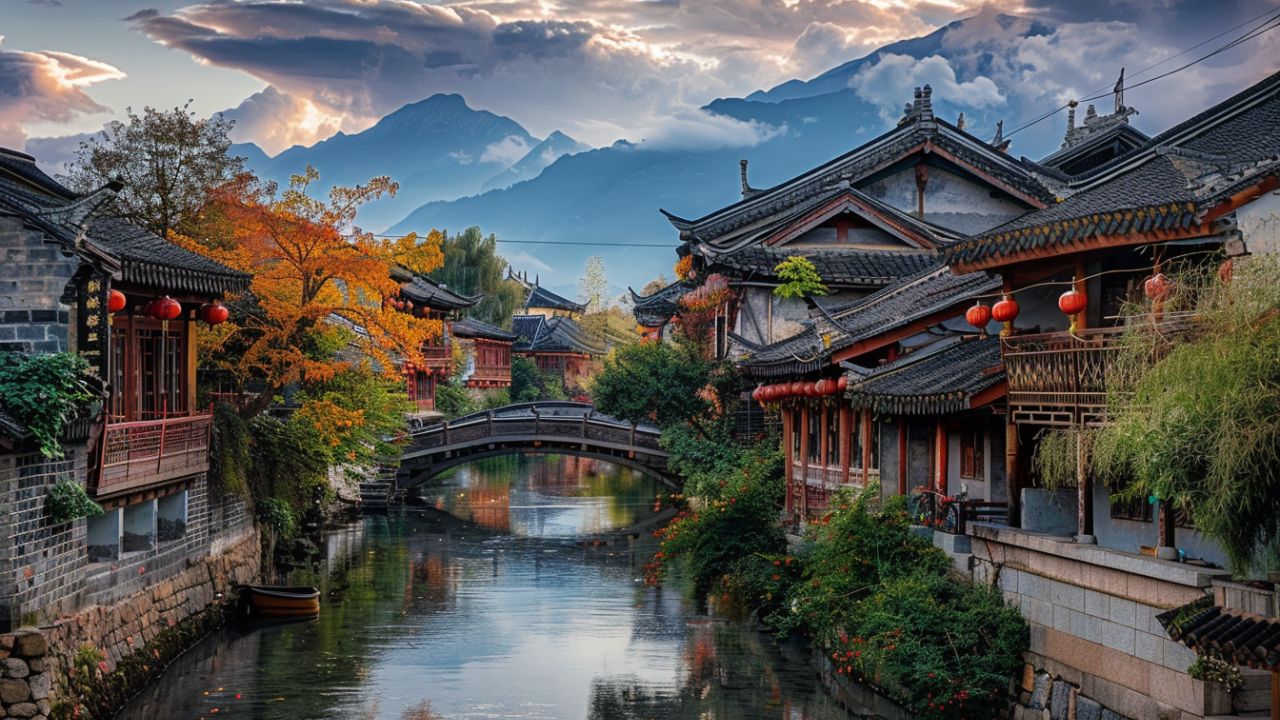
Tips for Visiting
- Best Time to Visit: The best time to visit Lijiang Ancient Town is during spring (March to May) and autumn (September to November) when the weather is mild and pleasant. Avoid the peak tourist seasons during Chinese national holidays to escape the crowds.
- Getting Around: The town is best explored on foot due to its pedestrian-friendly streets. Wear comfortable shoes as the cobblestone streets can be uneven.
- Respect Local Customs: The Naxi people are very proud of their heritage. Be respectful of local customs, especially when visiting religious sites and interacting with locals.
- Photography: Early mornings and late afternoons are the best times for photography due to softer light and fewer tourists. Always ask for permission before photographing locals.
- Language: While Mandarin is widely spoken, learning a few basic phrases in the local Naxi language can enhance your experience and show respect for the local culture.
- Local Cuisine: Don’t miss trying local dishes such as Naxi barbecue, Lijiang baba (a type of flatbread), and the region’s famous Yunnan coffee.
- Shopping: Bargain respectfully when shopping for local crafts. Popular souvenirs include Naxi embroidery, Dongba paintings, and local silverware.
Tiger Leaping Gorge
Tiger Leaping Gorge is located between Jade Dragon Snow Mountain and Haba Snow Mountain in Yunnan and it is one of the deepest and most spectacular river canyons in the world. This breathtaking natural wonder is formed by the Jinsha River, a primary tributary of the Yangtze River, cutting through towering cliffs that reach up to 3,790 meters (12,434 feet) above the river. The gorge is approximately 16 kilometers (10 miles) long and offers some of the best trekking experiences in China, attracting adventurers and nature enthusiasts from around the globe.
Highlights
- Upper Gorge: The starting point for most visitors, featuring the famous Tiger Leaping Rock where, according to legend, a tiger once leaped across the river to escape a hunter. This section offers dramatic views and easy access.
- Middle Gorge: Known for its challenging trails and breathtaking scenery, the Middle Gorge is popular among experienced hikers. The views of the rushing river, steep cliffs, and terraced fields are awe-inspiring.
- Lower Gorge: This section is less visited but equally beautiful. The trails are less strenuous, making it suitable for casual hikers and those looking to enjoy the scenic beauty without too much effort.
- Naxi Family Guesthouse: A popular stop for trekkers, offering accommodation, meals, and a glimpse into the traditional Naxi way of life. The guesthouse provides a great rest point with stunning views of the gorge.
- Halfway Guesthouse: Another key stop along the trek, known for its “incredible view terrace” that offers panoramic views of the gorge. It’s a great place to rest, eat, and take in the scenery.
- 28 Bends: The most challenging part of the trek, consisting of a series of steep switchbacks that test the stamina of hikers. The effort is rewarded with unparalleled views of the gorge and surrounding mountains.
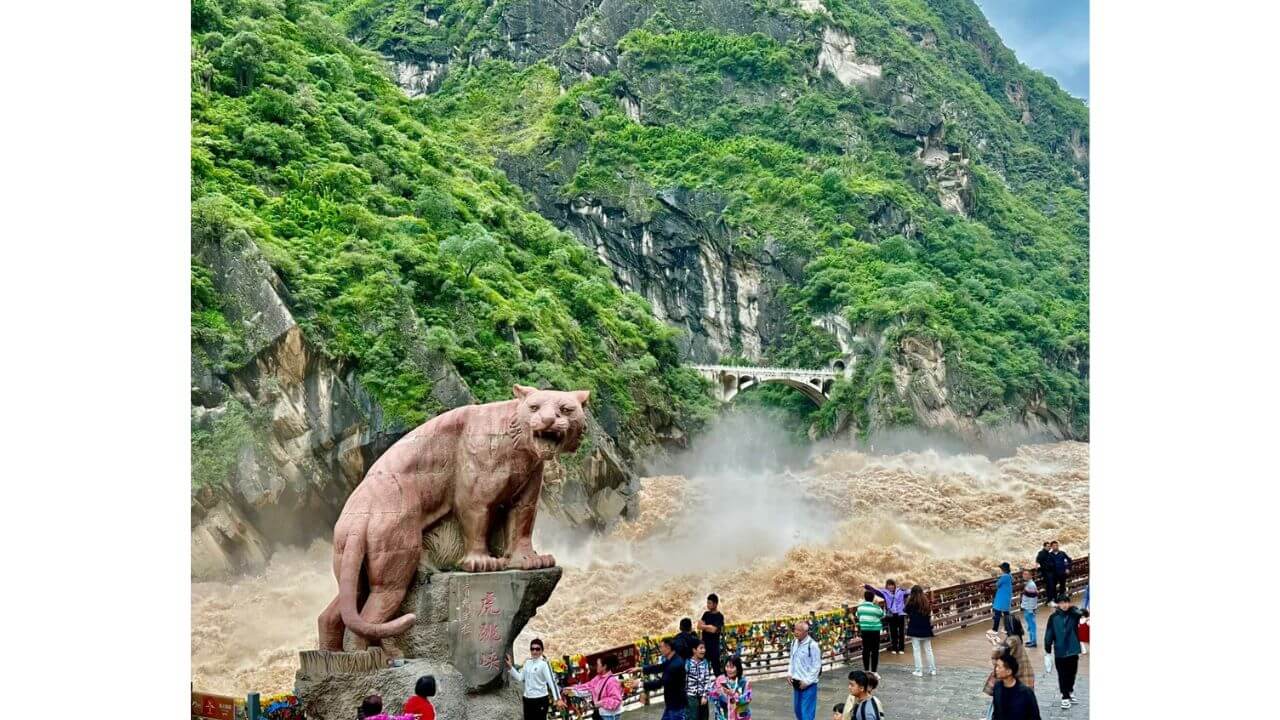
Tips for Visiting
- Best Time to Visit: The best times to visit Tiger Leaping Gorge are during spring (March to May) and autumn (September to November) when the weather is cool and dry. Avoid the rainy season (June to August) due to potential landslides and slippery trails.
- Preparation: Ensure you are physically prepared for the trek. The trails can be challenging, especially in the Middle Gorge section. Wear sturdy hiking boots and bring a walking stick for added stability.
- Pack Essentials: Carry plenty of water, snacks, and high-energy foods. Pack light but bring essentials like a first-aid kit, sunblock, hat, and layered clothing to adjust to changing temperatures.
- Respect Nature and Local Culture: Follow the Leave No Trace principles to preserve the natural beauty of the gorge. Respect local customs and traditions, and be mindful when interacting with the Naxi people and other locals.
- Safety: Always stay on marked trails and avoid risky shortcuts. Inform someone of your trekking plans and estimated return time. In case of emergency, local guesthouses and guides can provide assistance.
- Guides and Tours: While the trails are well-marked, hiring a local guide can enhance your experience by providing insights into the region’s geology, flora, fauna, and local culture.
- Transportation: The gorge is accessible from Lijiang and Shangri-La by bus or private car. Ensure you have a reliable mode of transport arranged for your return journey.
- Photography: Early mornings and late afternoons offer the best light for photography. Capture the dramatic landscapes, rushing waters, and stunning mountain vistas, but be cautious near the edge of cliffs.
- Weather Awareness: Weather can change rapidly in the gorge. Be prepared for rain, strong winds, and temperature fluctuations, especially at higher elevations.
Dali Ancient City
Another must visit site in Yunnan- Dali Ancient City. It is a historic and cultural gem renowned for its well-preserved ancient architecture, vibrant local culture, and stunning natural surroundings. The city dates back to the Tang Dynasty (618-907 AD) and has been a significant cultural and economic center for centuries. Nestled between the Cangshan Mountains and Erhai Lake, Dali Ancient City offers a picturesque setting with a rich history, making it a popular destination for travelers seeking both cultural experiences and natural beauty.
Highlights
- Ancient City Walls and Gates: The well-preserved city walls and gates, including the iconic South and North Gates, provide a glimpse into the city’s historical significance and architectural style.
- Foreigner Street (Huguo Road): A lively street lined with shops, cafes, and restaurants, offering a blend of local and international cuisines. It’s a great place to experience the city’s vibrant atmosphere.
- Three Pagodas: Located just outside the ancient city, the Three Pagodas are an iconic symbol of Dali. These ancient structures, dating back to the Tang Dynasty, are set against the backdrop of the Cangshan Mountains and offer a serene and picturesque setting.
- Erhai Lake: One of the largest freshwater lakes in China, Erhai Lake is known for its crystal-clear waters and beautiful scenery. Boat rides and cycling tours around the lake are popular activities.
- Cangshan Mountain: Offering breathtaking views of the city and Erhai Lake, Cangshan Mountain is a great destination for hiking and exploring. The mountain is home to diverse flora and fauna, making it a haven for nature enthusiasts.
- Dali Ancient Town Museum: This museum provides insights into the history and culture of Dali, showcasing artifacts, photographs, and exhibits that reflect the city’s rich heritage.
- Temple of the City God: A historic temple dedicated to the city god, it is a place of worship and cultural significance, offering a peaceful retreat within the bustling city.
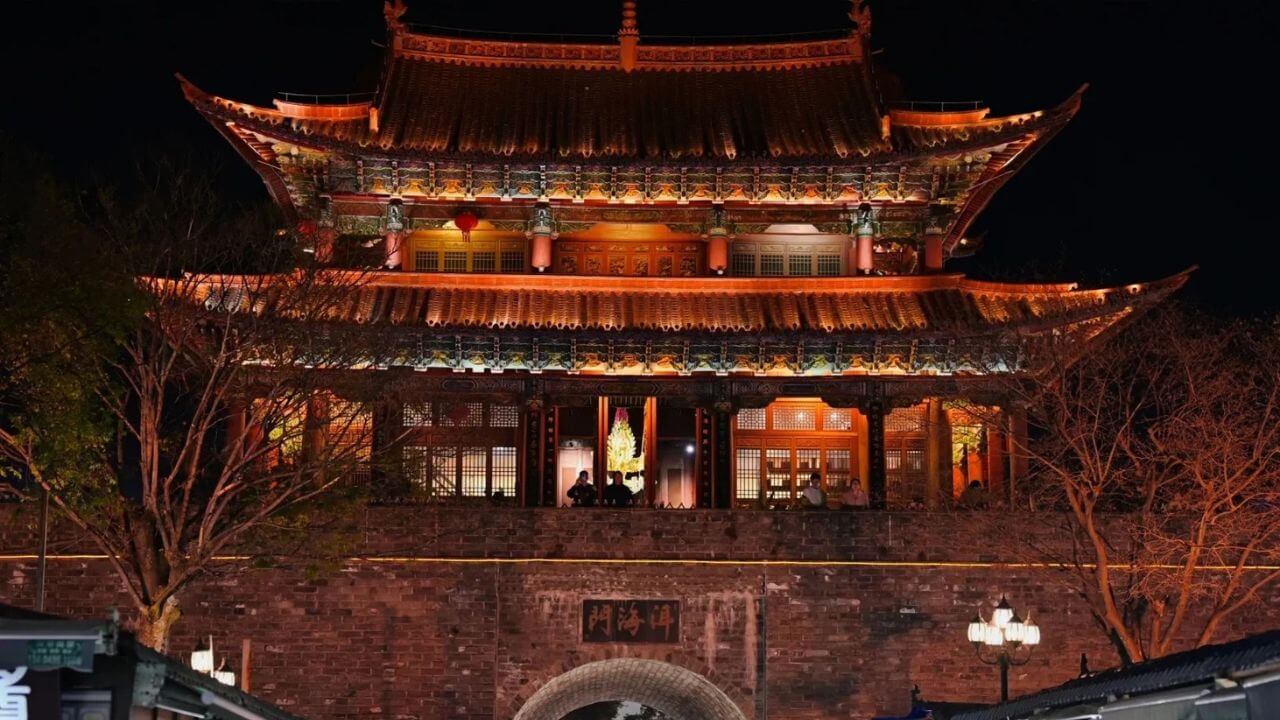
Tips for Visiting Dali Ancient City
- Best Time to Visit: The best times to visit Dali Ancient City are during spring (March to May) and autumn (September to November) when the weather is mild and pleasant. Avoid the peak tourist seasons during Chinese national holidays to enjoy a more relaxed experience.
- Getting Around: The ancient city is best explored on foot due to its pedestrian-friendly streets. Bicycles and electric scooters are also popular and can be rented locally for exploring the surrounding areas.
- Local Cuisine: Don’t miss trying local dishes such as Dali-style fish, Bai cuisine, and the famous “crossing the bridge” noodles. Street food vendors offer a variety of delicious snacks worth sampling.
- Shopping: Bargain respectfully when shopping for local crafts. Popular souvenirs include tie-dye fabrics, handmade silver jewelry, and traditional Bai clothing.
- Photography: Early mornings and late afternoons are the best times for photography due to softer light and fewer tourists. Capture the ancient architecture, bustling streets, and stunning natural landscapes.
- Cultural Respect: Be respectful of local customs and traditions, especially when visiting temples and interacting with the Bai people. Dress modestly and follow local etiquette.
- Stay Hydrated: The altitude in Dali is about 2,000 meters (6,562 feet) above sea level. Drink plenty of water and take it easy for the first couple of days to acclimatize.
- Weather Preparedness: The weather in Dali can be unpredictable, so pack layers and be prepared for sudden changes. Rain showers are common, especially in the summer.
- Local Festivals: If possible, plan your visit around local festivals such as the March Fair (San Yue Jie) or the Torch Festival, which offer vibrant displays of local culture, music, and dance.
Stone Forest (Shilin)
The Stone Forest is a remarkable karst landscape also known as Shilin in Chinese. It is located about 90 kilometers (56 miles) southeast of Kunming. Covering an area of approximately 500 square kilometers (193 square miles), the Stone Forest is a UNESCO World Heritage Site and one of China’s most unique natural wonders. The site features towering limestone formations that resemble a forest of stone trees, some of which are over 270 million years old. The dramatic and surreal landscape makes it a popular destination for both tourists and geologists.
Highlights
- Major Stone Forest: The central area of the Stone Forest, known for its dense concentration of towering limestone pillars. Visitors can explore winding paths and admire the impressive formations that rise up to 30 meters (98 feet) high.
- Minor Stone Forest: A quieter area compared to the Major Stone Forest, offering equally stunning limestone formations with fewer crowds. It’s an ideal spot for a more peaceful exploration.
- Naigu Stone Forest: Located about 10 kilometers (6.2 miles) from the main site, this area features black stone formations and a more rugged terrain. It is less visited and provides a more pristine experience.
- Qifeng Cave: A fascinating karst cave within the Stone Forest area, featuring stalactites, stalagmites, and other unique limestone formations. Guided tours are available to explore the cave’s depths.
- Zhiyun Cave: Another impressive cave in the Stone Forest, known for its intricate limestone formations and underground river. The cave is beautifully illuminated, enhancing the natural beauty of its features.
- Ashima Stone: Named after a legendary Yi girl, Ashima, this stone formation resembles a slender girl and is a symbol of love and beauty. It is one of the most famous and photographed formations in the Stone Forest.
- Lake Forest: A serene area within the Stone Forest, featuring picturesque lakes surrounded by stone formations. It’s a great spot for relaxing and enjoying the natural beauty of the landscape.
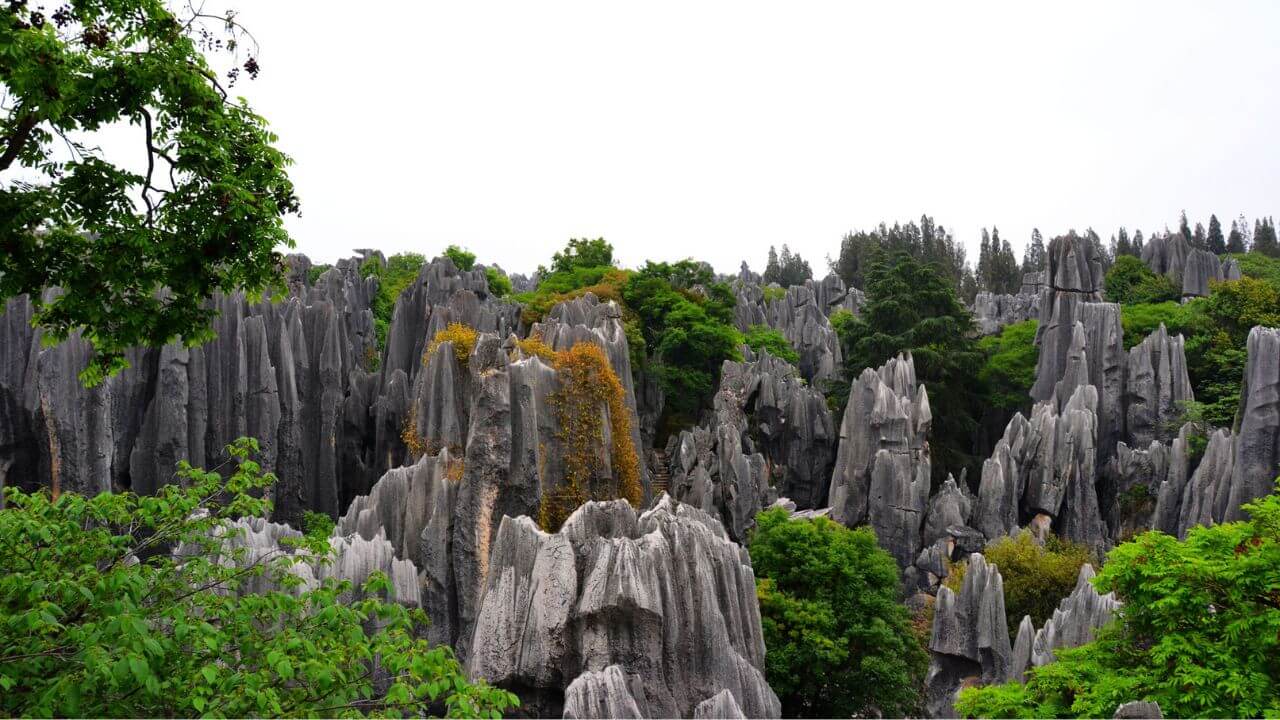
Tips for Visiting
- Best Time to Visit: The best time to visit the Stone Forest is during spring (March to May) and autumn (September to November) when the weather is mild and the landscape is at its most vibrant. Avoid visiting during Chinese national holidays to escape the crowds.
- Getting There: The Stone Forest can be reached by bus or car from Kunming. Organized tours are also available and often include transportation, guides, and entry fees.
- Entry Fees: The entry fee for the Stone Forest is around 175 RMB (approximately $25 USD). Additional fees may apply for guided tours and entrance to specific caves.
- Exploration Tips: Wear comfortable walking shoes as exploring the Stone Forest involves a lot of walking and navigating uneven terrain. Bring water, snacks, and sun protection, especially if you plan to spend the whole day exploring.
- Guided Tours: Consider hiring a local guide to enhance your experience. Guides can provide historical context, geological information, and help you navigate the most interesting parts of the forest.
- Respect Nature: Follow designated paths and avoid climbing on the limestone formations to preserve the natural environment. Dispose of trash properly and respect the local flora and fauna.
- Photography: Early mornings and late afternoons offer the best light for photography. Capture the towering limestone formations, the interplay of light and shadow, and the lush greenery that contrasts with the stone.
- Local Culture: The Stone Forest is located in an area inhabited by the Sani people, a branch of the Yi ethnic group. Take the opportunity to learn about their culture, traditions, and folklore, which are closely tied to the landscape.
- Facilities: The main tourist area has facilities such as restrooms, restaurants, and souvenir shops. Plan your visit to make use of these amenities, especially if you’re spending the entire day at the site.
- Weather Preparedness: The weather can change quickly, so bring layers and be prepared for sudden rain showers. A light rain jacket or umbrella can be handy.
Yuanyang Rice Terraces
As a tour guide I always recommend to visit the Yuanyang Rice Terraces. They are a breathtaking example of ancient agricultural engineering and a testament to the ingenuity of the Hani people. These terraces, carved into the slopes of the Ailao Mountains, cover an area of over 1,000 square kilometers (386 square miles) and have been cultivated for more than 1,300 years. The landscape is characterized by its cascading layers of terraces that rise up to 3,000 steps high, creating a stunning visual spectacle. In 2013, the Yuanyang Rice Terraces were designated as a UNESCO World Heritage Site, highlighting their cultural and agricultural significance.
Highlights of Yuanyang Rice Terraces
- Duoyishu Village: Known for its spectacular sunrise views, Duoyishu Village offers one of the best vantage points to see the terraces bathed in the golden morning light. The misty mornings add a mystical atmosphere to the scenery.
- Bada Scenic Area: Famous for its panoramic views, especially at sunset, Bada Scenic Area provides a breathtaking overview of the terraces stretching across the valley. The reflections of the sky in the flooded fields create a mesmerizing effect.
- Laohuzui (Tiger Mouth) Scenic Area: This area is renowned for its dramatic landscape and intricate terrace patterns. It is particularly striking during the late afternoon when the sun casts long shadows, accentuating the terraces’ contours.
- Quanfuzhuang Village: A lesser-known but equally beautiful spot, Quanfuzhuang offers a quieter and more intimate experience of the terraces. The village is surrounded by lush greenery and provides a closer look at the daily life of the Hani people.
- Hani Ethnic Culture: The Hani people have a rich cultural heritage, and visitors can experience their traditional customs, festivals, and architecture. The Mushroom Houses, unique to the Hani, are distinctive clay dwellings with thatched roofs.
- Rice Planting and Harvesting Seasons: The terraces offer different scenic beauty throughout the year. The fields are flooded with water from November to April, creating mirror-like reflections. Planting season starts in May, and the terraces turn green. The harvest season from September to October showcases golden fields.
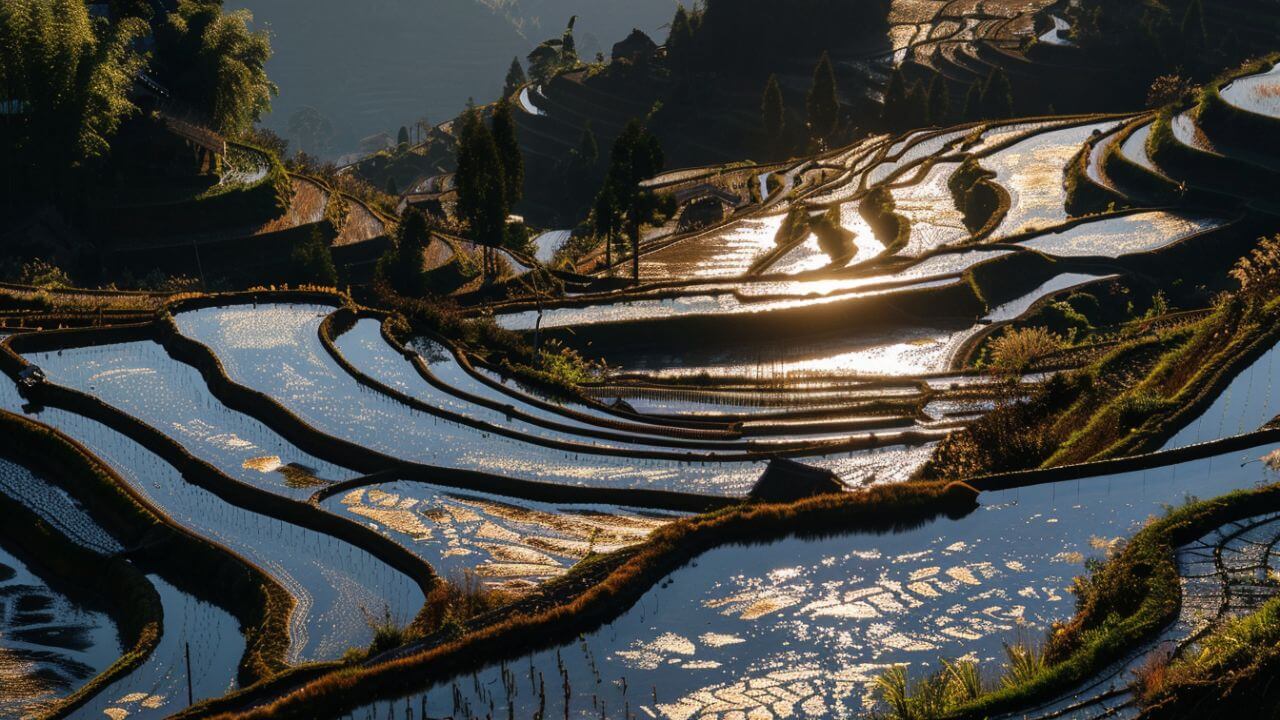
Tips for Visiting
- Best Time to Visit: The best times to visit the Yuanyang Rice Terraces are during the winter months (November to April) when the fields are filled with water, creating stunning reflections, and during the harvest season (September to October) when the fields turn golden.
- Getting There: Yuanyang is about 300 kilometers (186 miles) south of Kunming. Buses run regularly from Kunming to Yuanyang Xinjie Town, from where you can hire a taxi or local transport to reach the terraces.
- Exploration Tips: Wear comfortable walking shoes as exploring the terraces involves hiking and navigating uneven terrain. Bring a hat, sunscreen, and a light jacket, as the weather can change quickly in the mountains.
- Photography: Early mornings and late afternoons offer the best lighting for photography. Capture the terraces’ reflections, the patterns created by the rice fields, and the surrounding mountain scenery.
- Respect Local Culture: The terraces are a living, working landscape, and the Hani people still practice traditional farming here. Be respectful of their culture and daily activities. Ask for permission before photographing locals.
- Local Cuisine: Don’t miss trying local dishes made from the red rice cultivated in the terraces. The Hani people’s cuisine features unique flavors and ingredients sourced from the surrounding environment.
- Local Guides: Consider hiring a local guide to gain deeper insights into the history, culture, and agricultural practices of the Hani people. Guides can also help you navigate the best spots for photography and sightseeing.
- Respect the Environment: Follow sustainable tourism practices by staying on designated paths, not littering, and being mindful of the delicate ecosystem that supports the rice terraces.
Shangri-La
Shangri-La, formerly known as Zhongdian is a stunning town located in the Diqing Tibetan Autonomous Prefecture in Yunnan. Nestled at an altitude of about 3,200 meters (10,500 feet), Shangri-La is known for its breathtaking landscapes, rich Tibetan culture, and tranquil atmosphere. The town serves as a gateway to exploring the Tibetan Plateau and offers visitors a blend of natural beauty, cultural richness, and spiritual serenity.
What to visit in Shangi- La
- Songzanlin Monastery: Often referred to as the “Little Potala Palace,” this large Tibetan Buddhist monastery is the most important religious site in Shangri-La. It features stunning architecture, intricate murals, and a serene atmosphere, offering insight into Tibetan Buddhism.
- Old Town (Dukezong Ancient Town): With its traditional Tibetan architecture, narrow cobblestone streets, and charming atmosphere, the Old Town is a great place to explore local culture. Highlights include the Guishan Park, with its giant prayer wheel, and numerous shops, cafes, and restaurants.
- Pudacuo National Park: This expansive park covers around 1,300 square kilometers (502 square miles) and is known for its pristine natural beauty, including alpine lakes, lush forests, and diverse wildlife. Key attractions within the park include Shudu Lake and Bita Lake.
- Napahai Lake: A seasonal lake and grassland located about 10 kilometers (6.2 miles) from Shangri-La, Napahai is a beautiful spot for birdwatching, especially during the migratory season when black-necked cranes can be seen.
- Tiger Leaping Gorge: Located about 100 kilometers (62 miles) from Shangri-La, this dramatic gorge is one of the deepest in the world and offers spectacular trekking opportunities along its rugged paths.
- White Water Terrace (Baishuitai): Known for its stunning limestone formations created by mineral-rich spring water, Baishuitai is a scenic and culturally significant site for the local Naxi people.
- Ganden Sumtseling Monastery: An important monastery for Tibetan Buddhism, this site offers a peaceful environment for visitors to learn about Tibetan culture, history, and religion.
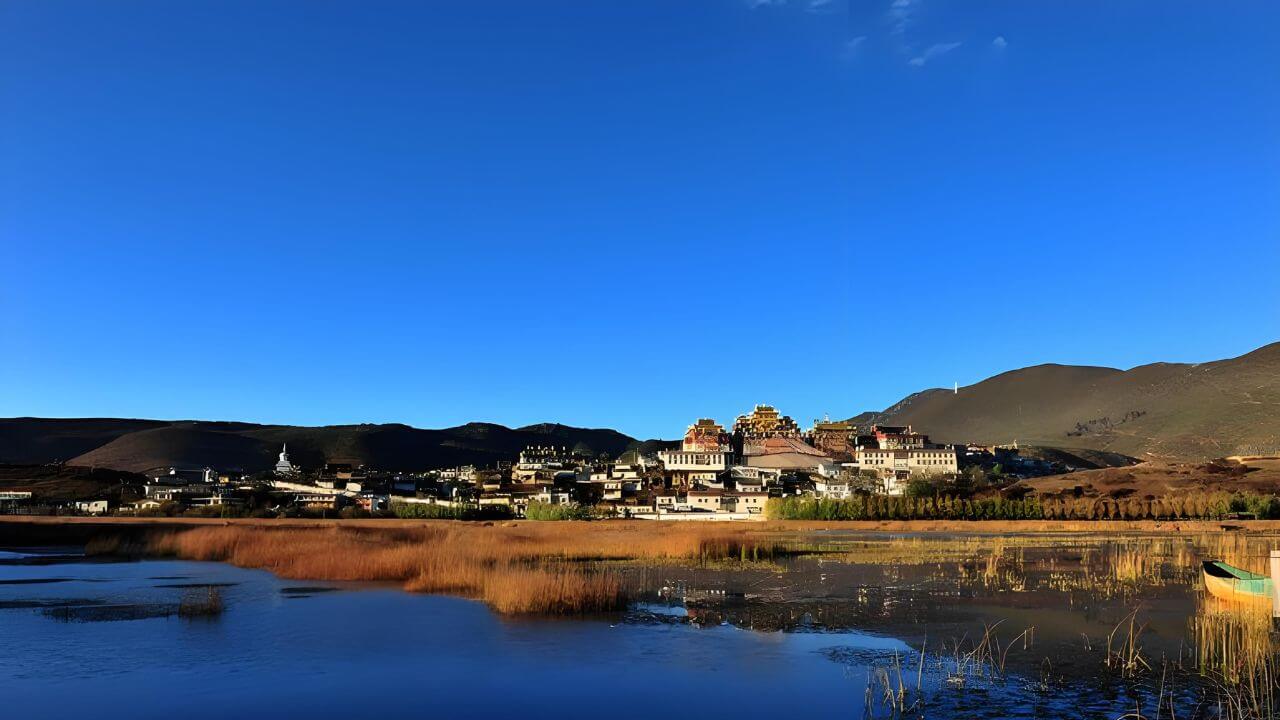
Tips for Visiting
- Best Time to Visit: The best times to visit Shangri-La are during spring (April to June) and autumn (September to November) when the weather is mild, and the landscapes are at their most beautiful. Avoid the winter months (December to February) when temperatures can be extremely cold and some areas may be inaccessible.
- Accommodation: Choose from a range of accommodations, from traditional Tibetan guesthouses to modern hotels. Staying in the Old Town can provide a more immersive cultural experience.
- Altitude Acclimatization: Shangri-La is at a high altitude, so it’s important to acclimatize slowly to avoid altitude sickness. Drink plenty of water, avoid strenuous activities for the first couple of days, and consider bringing medication for altitude sickness.
- Getting Around: The town is best explored on foot, especially the Old Town area. For trips to surrounding attractions, hiring a local driver or joining a guided tour can be convenient and informative.
- Local Cuisine: Sample traditional Tibetan dishes such as yak meat, butter tea, and tsampa (barley flour). The local markets and restaurants offer a variety of delicious options.
- Respect Local Culture: Shangri-La is home to a significant Tibetan population. Be respectful of local customs and traditions, especially when visiting religious sites. Dress modestly and ask for permission before photographing people or religious ceremonies.
- Weather Preparedness: The weather can be unpredictable, so pack layers and be prepared for sudden changes in temperature. A warm jacket, hat, and gloves are essential, especially in the evenings.
- Photography: Early mornings and late afternoons offer the best light for photography. Capture the stunning landscapes, traditional architecture, and vibrant local life, but always be respectful of people’s privacy.
- Local Festivals: If possible, plan your visit around local festivals such as the Tibetan New Year (Losar) or the annual horse racing festival, which offer vibrant displays of local culture, music, and dance.
Kunming
Kunming is the capital city of Yunnan Province and it is often referred to as the “Spring City” due to its pleasant, mild climate throughout the year. Situated at an elevation of approximately 1,900 meters (6,234 feet), Kunming enjoys fresh air, lush green parks, and a relaxed atmosphere. As a cultural and historical hub, the city offers a blend of modernity and tradition, with diverse attractions ranging from ancient temples and bustling markets to contemporary museums and vibrant nightlife.
Do not miss in Kunming
- Green Lake Park (Cuihu Park): A beautiful urban park located in the city center, known for its picturesque lakes, willow trees, and vibrant lotus flowers. It’s a popular spot for locals and tourists to relax, exercise, and enjoy seasonal birdwatching, especially the wintering red-beaked gulls.
- Yunnan Nationalities Village: An open-air museum showcasing the diverse ethnic cultures of Yunnan Province. The village features traditional architecture, performances, and crafts from various ethnic groups, providing a fascinating insight into the region’s cultural diversity.
- Western Hills (Xishan): A scenic area located on the western shore of Dianchi Lake, offering panoramic views of the lake and city. The hills are dotted with temples and pagodas, including the iconic Dragon Gate, carved into the cliffs.
- Dianchi Lake: The largest freshwater lake in Yunnan, known for its serene beauty and recreational activities. Visitors can enjoy boat rides, cycling along the lakeshore, and visiting the nearby Yunnan Nationalities Village.
- Golden Temple (Jindian Park): A Taoist temple made entirely of bronze, located in a lush forested area on Mingfeng Hill. The temple is known for its intricate design and tranquil surroundings, making it a peaceful retreat from the bustling city.
- Yuantong Temple: One of the oldest and most important Buddhist temples in Kunming, featuring beautiful architecture, serene gardens, and a large pond filled with fish and turtles. It’s a place of worship and tranquility.
- Kunming Botanical Garden: Home to a vast collection of plant species from Yunnan and other regions, the garden is a paradise for nature enthusiasts and offers a peaceful escape from the city’s hustle and bustle.
- Dynamic Yunnan: A spectacular performance showcasing the traditional music, dance, and culture of Yunnan’s ethnic minorities. The show is a vibrant and colorful representation of the region’s rich heritage.

Tips for Visiting
- Best Time to Visit: Kunming can be visited year-round due to its mild climate. However, spring (March to May) and autumn (September to November) are particularly pleasant with comfortable temperatures and fewer tourists.
- Accommodation: Kunming offers a range of accommodations, from budget hostels to luxury hotels. Staying in the city center provides easy access to major attractions, shopping, and dining options.
- Getting Around: Kunming has an efficient public transportation system, including buses and a metro. Taxis and bike-sharing services are also readily available. For exploring nearby attractions like the Stone Forest, organized tours or hiring a private car are convenient options.
- Local Cuisine: Don’t miss the chance to try local Yunnan cuisine, known for its fresh ingredients and unique flavors. Popular dishes include “Over the Bridge” rice noodles, wild mushrooms, and various spicy and sour specialties. The night markets offer a great variety of street food.
- Safety: Kunming is generally a safe city for tourists. However, like any major city, be mindful of your belongings, especially in crowded areas. Stay hydrated and take precautions against altitude sickness if you’re sensitive to higher elevations.
- Local Festivals: If possible, plan your visit around local festivals such as the Kunming International Cultural Tourism Festival or the Torch Festival of the Yi people, which offer vibrant cultural displays and unique experiences.

Helen Wang
Travel Advisor & Guide Expert
I started my travel career in 2005 and have since become an expert in Tibet and China’s travel destinations and helping travelers plan unforgettable trips.
For expert travel advice to China or Tibet, feel free to contact me.